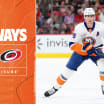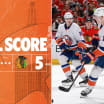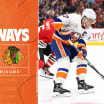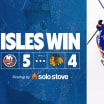William Shakespeare couldn't have known about the Islanders when he wrote the deathless lines, "Sweet are the uses of adversity," but the prophesy sure suits the club's travails -- and success -- in their maiden NHL season, 1972-73.
Like other newsmen covering the baby team, my sentiment could be summed up with the bromide, hope for the best; but expect the worst.
Training camp and exhibition games gave me the feeling that it would be the latter more than the former. This opinion was shared by some of my colleagues who included Tim Moriarty who had moved from United Press International to Newsday, and Sid Payne of the Long Island Press.
Maven's Memories: Big Wins from the Rookie Season
Stan Fischler reflects on the impactful wins of the 1972-73 season

© B Bennett/Getty Images
By
Stan Fischler
Special to NHL.com
At the time, there were unknowns all over the place but the one man we all knew was Bill Torrey's coaching choice, Phil Goyette. Respected as a competent center, the French-Canadian had played for the Montreal Canadiens, New York Rangers, St. Louis Blues and Buffalo Sabres over a 16-year NHL career.
I attended Goyette's introduction to the press at a Manhattan restaurant and was amused when someone mentioned that Phil had arrived with no genuine coaching experience.
Since The Maven always relishes a good laugh -- or quip -- I got a kick out of Phil's perfect squelch: "I coached the Sabres for one game," he shot back, "and we won. So I'm batting one thousand."
That record didn't last long. The Isles lost their first pre-season game 4-1 to their expansion cousins, the Atlanta Flames. Bow Tie Bill had a good excuse: the club had to endure an eight-hour bus ride from Peterborough, Ontario to Drummondville, Quebec where the match was played.
When someone asked Torrey why the team hadn't taken a plane, Bill had the answer: "Had we flown, we would have spent as much time getting back and forth to the airports.
"Besides, I have an awful lot of kids here who don't know each other yet," he added. "The bus helped make for a social affair."
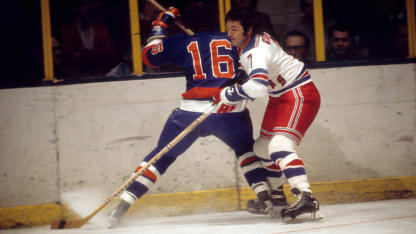
© Melchior DiGiacomo/Getty Images
The Islanders' first exhibition game at home on September 27, 1972 featured the Rangers, who topped the Locals 6-4. The laugh of the night was provided by a fan carrying a banner: LET'S GO NEW YORK!?
The official home opener was played against the Atlanta Flames on October 7, 1972 before a crowd of 12,221. The Long Island Faithful were finally rewarded with the Islanders first-ever regular season goal when captain Ed Westfall scored at 19:29 of the second period. Billy Harris made it close with a power play tally at 16:51 of the third period, but that was a case of "close-but-no-cigar."
Atlanta came out on top 3-2, but Nassau Veterans Memorial Coliseum emerged the winner after NHL President Clarence Campbell declared: "It's a magnificent place to watch hockey."
And he was right. Over the years, the Coliseum was praised not only for its excellent sight lines but also its overall ambience and fan friendliness.
Just five nights after the inaugural home game, we were treated to the franchise's first victory. Facing the Los Angeles Kings, who had entered the league during its first expansion in 1967-68, the Isles displayed a comeback spirit.
Like others in the crowd, I was exhilarated when Billy Harris tied the game 1-1 in the middle frame and then again when Harris and Germain Gagnon rallied the sextet to a come-from-behind 3-2 triumph.
Tim Moriarty echoed my feelings when he wrote, "It was a game replete with thrills, including a missed penalty shot by Harris and some brilliant netminding by Bill Smith who finished with 28 saves."
From a journalist's perspective, I was amused by the post-game reactions of the two coaches. The Kings' Bob Pulford turned his back on us, refusing a post-game comment.
Moriarty: "He didn't appreciate the fact that his club would enter the record book as the Islanders' first victim."
A gleeful Goyette noted that his club suddenly was locked in a tie with the Rangers and ahead of the Boston Bruins. "I hope it's not short-lived," smiled Phil.
It would be, but not until 11 days after Goyette had enjoyed his most unlikely victory of his short-lived coaching career.
The eventual sacking of likable Phil surprised many of us since Goyette had led the Isles to their most significant win of the season, what became notorious as the club's "Boston Massacre." The date: January 18, 1973. The site: Boston Garden.
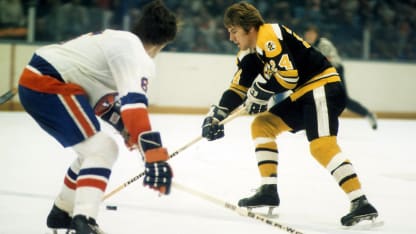
© Melchior DiGiacomo/Getty Images
I recall that the Boston media expected the Bruins to slap down the Nassaumen with ease. After all, by now they had lost their 12 previous games.
But that was then and this was now -- a night that featured one of the zaniest contests in the club's history.
One-two-three-four-five; the Isles had a quintet of red lights in the opening period alone. Even Bow Tie Bill was incredulous as we all were. "Western Union is going to have all kinds of queries when they send out that score," the GM chuckled.
Torrey's smile turned to a frown as Boston rapidly netted three goals in five minutes against Smith. All of a sudden, the Beantowners poured it on early in the third, tightening the count to 7-6; but significantly New York held the lead -- although by a gossamer string.
Tom Miller and Billy Harris finally allowed their boss to breathe easier with another pair of goals and, ultimately, the Islanders skated off with an unlikely 9-7 win.
Like myself, Boston fans were stunned to the very core. A middle-aged woman -- a Bruins fan, of course -- left the arena ahead of Torrey and exclaimed, "I expected to see a rout tonight."
Overhearing the observation, Bow Tie Bill couldn't resist the perfect punch line: "What did she think that was?"
For me, it was the Islanders best win of the season, but not for Phil Goyette.
Eleven days later he was dismissed and replaced by another former Rangers center, Earl Ingarfield, who did better than Phil, but not by a lot.
Had The Maven been writing the headline for Ingarfield's short tenure behind the bench, I would have penned: RUSTY ISLANDERS GET SHOT OF EARL!
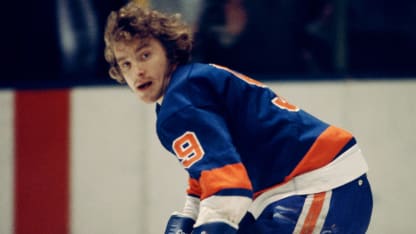
© Bruce Bennett/Getty Images
LISTS: SEVEN SIGNIFICANT WINS IN THE ROOKIE SEASON.
1. ISLES BEAT CALIFORNIA GOLDEN SEALS, NOVEMBER 1, 1972.
As challenging as the maiden season may have been, the Nassaumen found a patsy on the West Coast. The initial win -- 6-2 -- at the Oakland-Alameda County Coliseum was meaningful since it marked the first time in club history that it recorded six goals in a game. Germain Gagnon delivered the first hat trick in Isles annals. It also represented their first road win.
2. MASTERY OVER THE SEALS IS NO ACCIDENT, NOVEMBER 21, 1972.
Just 20 days after punishing the Seals on the left coast, coach Phil Goyette's team did it again only this time in Uniondale. What I liked most about this triumph was that four different players delivered the goals. Tom Miller, who later would prove to be a star in the "Boston Massacre," produced two assists against the visitors from Oakland.
3. THE BOSTON MASSACRE, JANUARY 18, 1973.
Islanders fans who weren't there couldn't believe it. For that matter, neither could I. Their conspicuously underdog heroes surprised the Bostonians with five goals in the first period. Had I thought of it at the time, I would have called it "the dreaded five-goal lead." But that would come decades later. Sure enough, the Bruins counterattacked and by the third period, the home club was now behind by only one measly goal. (7-6). Fortunately, Tom Miller and Billy Harris soon provided the "cushion" scores, clinching New York's 9-7 victory. From then, to eternity, the game will be labeled "The Boston Massacre," Islanders-style!
4. UPSET OF THE RED WINGS IS EXHILARATING, FEBRUARY 24, 1973.
For me, it was one thing to defeat an expansion team such as Oakland but it was more thrilling to watch an Original Six club get beaten. Detroit was loaded with stars such as Hall of Famers Marcel Dionne and Alex Delvecchio as well as sharpshooting Mickey Redmond. The 4-2 win in Uniondale featured Brian Spencer's pair of red lights and resulted in his season's best game. I loved when an underdog such as Spinner earned the spotlight.
5. A BUSHEL OF GOALS OVERWHELM THE CANUCKS, MARCH 3, 1973.
I remember this as a night for massive hoarse throats across the Coliseum. An outburst that resulted in a 9-3 victory will do that. Bob Cook scored three of his team's record-setting output while Dave Hudson set a club assist record with four helpers. Coincidentally, this was the franchise's first "Stick Night." The New York Times' review concluded: "Between New York's fancy shooting and the two fights, the fans thoroughly enjoyed themselves." The Maven as well in the press box.
6. NEW COACH, SAME RESULT AGAINST THE SEALS: MARCH 20, 1973.
Phil Goyette was gone as the first head coach, replaced by Earl Ingarfield, and still the Islanders enjoyed dominance over the Seals. The 6-3 decision in Uniondale marked the first season sweep by Torrey's outfit against any NHL club that year. Granted that the playoffs were out of the question, but journalists like me began to think that this win could be the start of something big. I had appreciated Ingarfield as a player and now he was showing me that he really could coach.
7. DOWNING THE PLAYOFF-BOUND FLYERS, MARCH 24, 1973.
This marked the first season when the Broad Street Bullies energetically were pushing around their foes. What impressed me was that the Isles were unimpressed by the Bobby Clarke-led squad. In this next-to-last home game of their initial season, the Isles beat Philly, 3-2, stretching their winning streak to a season-high three games. Billy Harris would tally his team-leading 26th goal, making Torrey's draft selection of the right wing look like a gem. Not to mention Bow Tie Bill's naming Ed Westfall the club's captain. Number 18 sealed the deal with the game-winner at 12:03 of the third period. The man with the "C" would become a leader among leaders.








